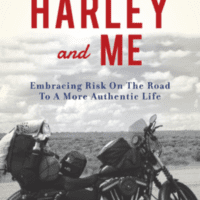Let’s just say it up front. Bernadette Murphy is a powerful woman, even if she’s petite and “bird boned.” She survived a childhood with a mentally ill mother. She raised three children. She’s a professor, a journalist, a marathoner, an ice climber, a Sierra hiker, and, as she tells us in her gripping memoir, Harley and Me: Embracing Risk on the Road to a More Authentic Life, a brave motorcyclist. This woman has a lot to brag about, and yet, thankfully, she is not casting for bad-ass cred in this memoir. Instead, we see a woman at midlife who’s questioning everything she’s been taught about gender roles and risk.
Not content to simply self-analyze, Murphy does her research. By interviewing experts in neuroscience, psychology, evolutionary history, and genetics, she puzzles out what compelled her to buy a Harley at age forty-eight and to make a cross-country road trip from LA to Milwaukee. The more important journey is her self-discovery. Married in her early twenties (after an unplanned pregnancy in her teens), she immediately started having children. Creating a stable home after her own difficult childhood with a mentally ill alcoholic mother was undoubtedly as emotionally challenging (and thrilling) as riding cross-country on a Harley. But once the children are launched, she feels a deadening inside. Her research explains how mothering creates oxytocin, the pleasure hormone, in female brains. Without the children around she isn’t getting that oxytocin buzz. Estrogen had brought out her nurturing impulses, but it also “excised the flinty dopamine, thrill-seeking drive.” When her estrogen starts to drop with perimenopause, that dopamine-driven, risk-taking impulse takes over. A week after her father dies, she buys Izzy, her Sportster Iron 883 Harley. Pretty soon she’s taking harrowing rides through LA canyons and leaving her husband of twenty-two years.
These rides, whether cross-country or simply around town, provide the strongest writing in the book:
I like the feel of the wind in my face and the wind slamming my chest. As the air temperature fluctuates, I feel alive, more aware of my surroundings, shivering when I make my way through extended cloud cover, then marveling in the sudden delight of warmth when I hit a patch of sun.
She describes the Southern California smells: chaparral, eucalyptus, a squashed lemon in the road, grilled onions at In ‘n’ Out Burger. She says, “I like how my helmet squeezes my face so that when I smile, my cheeks jam against the sides of the helmet.”
Descriptions of roads that “wind through canyons and over summits, presenting one stunning vista after another” are riveting. When she talks about falling off her Harley and lifting the 550-pound bike by herself (a trick of leverage and brute force), and even having an orgasm on the bike, she’s at her best. When she describes riding on the freeway in tandem with six other riders, the prose casts a spell. The riders communicate not through words, but through “telepathy, action, and grace. For the first time, I feel a deep sense of belonging.” She describes how “gravel stings my shins,” or how her “breath grows loud inside my helmet.”
There’s a gorgeous description of her eating a tomato after a thunderstorm in Wisconsin:
The sunlit tomato almost falls from its vine into my hand. It’s as big as a grapefruit and still warm from the earlier heat of the day, but washed in a sparkle of rainwater.
As appealing as the Midwestern gardens and storms may be, there are also vivid descriptions of so-called salad bars in Nebraska, with iceberg lettuce, “goopy blue cheese dressing,” and canned vegetables. Ah, the SoCal aesthete-athlete’s encounter with America’s middle! Veggies, veggies, in the fields everywhere, but not a fresh one in the restaurants.
I wish she had focused as sensuously on her interactions with family. She summarizes her father’s death in a few paragraphs. After bathing him, a passage I wished was more detailed and immediate, she says that he was a man who “both adored and terrified me.” More details about the terrifying aspects of that relationship are not forthcoming. Her mother’s mental illness and most of her own childhood and adolescence are covered parsimoniously. The same goes for her children and ex-husband. Her concerns are more with neuroscience than with excavating her human relationships. The dominant relationship is Murphy’s relationship to her own biochemistry.
Less interesting are passages when she explains precisely why motorcycling is her “pathway to a more authentic life.” She states that “just to get on a bike is to break prescribed gender roles even in this postfeminist age.” Is it a postfeminist age? I don’t think so, but she does write convincingly of the sexism among bikers. Although the interactions of neurotransmitters and hormones are accurate ways to understand the mind-body connection, at times this information could have been handled more economically. My sense that this material was redundant was confirmed when I found the exact text from page 202 repeated in the epilogue. Each chapter is structured to weave the research in with the personal story, but I found myself yearning to get out of the social science/neuroscience world and back into Murphy’s world—full of sensuous pleasures, triumphs, and failures.
Still, her research illuminates important issues. The aging brain needs more risk, rather than less in order to stay healthy. Some women experience increased libido in menopause. Although some humans are wired to take more physical risk than others, she makes clear that what constitutes risky behavior is idiosyncratic. “Financial, emotional, spiritual, and creative risk can all provide the same stimulation.” What’s truly refreshing is that she shows how the path to transformation is a rocky road. No easy 10 Steps to Survive Your Midlife Crisis provided here. Her story inspires without being tritely inspirational, and that is a real gift.




